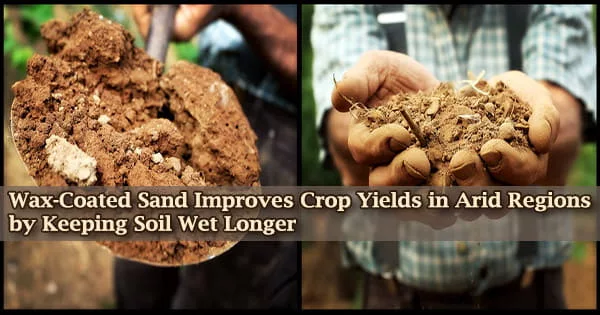Because the soil dries out rapidly in dry, hot climates, it is difficult to cultivate plants. Farmers in arid and semi-arid areas irrigate their crops with subterranean irrigation tubing networks and cover the ground with plastic sheets as a result. However, plastic sheets are costly and wasteful.
Researchers have now devised a simple, biodegradable wax-coated sand ground cover that keeps the soil moist and boosts crop yields, according to a study published in ACS Agricultural Science & Technology.
Farmers frequently collect water from neighboring waterways or underground aquifers to irrigate their crops. When growing plants in arid places, where the soil is primarily sand and can’t hold onto water properly, these supplies might quickly decrease.
One strategy to improve the efficiency of irrigated water is to make sure it stays in the soil long enough for plant roots to absorb it. Ground cover barriers, such as plastic sheets and synthetic nanomaterials, have been found in previous experiments to decrease evaporation and improve plant growth and agricultural yields.
Both, however, have the potential to leak undesirable substances into the soil, with unclear long-term consequences. To access these moisture sources, several plants and animals naturally generate waxy compounds that capture and pool water from fog or condensation.
Nature-inspired Himanshu Mishra and colleagues wanted to test whether they could coat sand with wax to create an environmentally friendly ground cover to minimize soil evaporation.
For their studies, the researchers used refined paraffin wax, a biodegradable product that is readily available in large amounts. They dissolved the wax in hexane and mixed it with silica sand. As the solvent evaporated, the grains were left with a 20-nm-thick wax layer.
The scientists found that spreading wax-coated sand in a thin layer over an open field in Saudi Arabia reduced soil moisture loss by 50-80%. Tomato, barley, and wheat plants mulched with the novel material produced significantly more fruit and grain than those growing on uncovered soil, according to field testing.
Furthermore, the waxy mulch, which could have worked as a food source for some of the microorganisms, had no negative impact on the microbial population around the plants’ roots and in the soil. According to the researchers, this basic nature-inspired device could make water consumption more efficient in arid locations.





